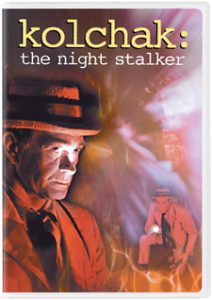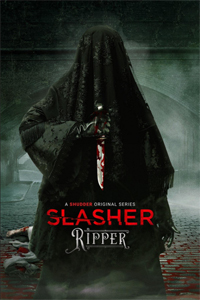For better or worse, “Slasher” gets ambitious by trying its first period-piece mystery, venturing to 1890s Toronto. Through two episodes, it’s slightly “for worse,” but not so much that I won’t stick with this proven series that has delivered a few strong seasons (1-3) and one hit-and-miss entry (4).
The Widow is a widow-maker
In Season 5, subtitled “Ripper” (Thursdays, Shudder), The Widow — conveniently draped in an impenetrable black veil — is killing various residents as payback for a mysterious misdeed from 12 years prior. This is a classic “Slasher” plot from creator Aaron Martin (who co-writes with Ian Carpenter).
At first, The Widow is supposedly killing the rich, but that doesn’t hold true on subsequent murders. Meanwhile, we wonder who disemboweled a young woman named Margaret in the street 12 years earlier. Anyone could be a suspect. As usual, “Slasher” flirts with making everyone unlikable, but stays slightly above water on that count.
“Slasher” Season 5: “Ripper” (2023)
Thursdays, Shudder (two episodes have aired so far)
Creator: Aaron Martin
Stars: Eric McCormack, Gabriel Darku, Sadie Laflamme-Snow
As for the believability of what we’re seeing, “Slasher” hits a low point. Director Adam MacDonald does a workmanlike but not quite convincing job of portraying 1890s Toronto. The clothing and props are on point, as is the occasional wall of fog, but the first odd thing I noticed is a flawlessly paved street.
An internet search tells me that paving did indeed come to Toronto around this time, but a line of dialog might’ve helped. Viewers of turn-of-the-20th-century Jack the Ripper riffs expect cobblestones and gaslights; sliding in some comments about asphalt and light bulbs (about a decade old at this point) would add verisimilitude.
Color-blind casting
On the other hand, “Ripper” is almost purposely not interested in details, judging by its choice to use color-blind casting. Black actor Gabriel Darku plays the lead detective, Rijkers, more than 60 years before the first black Canadian police officer in the real world. Medical examiner Dr. Israel, played by Lisa Berry, is also black.
This is a tricky subject, but it can’t be denied that realism is sacrificed when we see black officials in a time and place where there were no black officials in the real world. It also means race conflict can’t come into play, since the events are playing out in color-blind fashion.
Class conflict takes its place, particularly in the mansion of the three Botticelli sisters. This is also where we get the one notably sympathetic character: Verdi (Sadie Laflamme-Snow, a newcomer to Martin’s troupe). This innocent Cinderella figure has recently arrived from Boston.
Twenty-something Verdi is seemingly welcomed with open arms by 30-something Viviana (Paula Brancati) and 40-something Venetia (Sabrina Grdevich). But soon they are treating her like garbage, as oily newspaper baron Basil Garvey (Eric McCormack) has switched his attentions from Viviana to Verdi – despite protestations from the latter.

The ageless Brancati again plays the Canadian spin on boy-crazy valley girl, but the 1890s is the weirdest juxtaposition so far for that type of character. Brancati’s natural energy remains amusing, but it’s more out-of-place than ever.
Not entirely accurate
Granted, no cast member is convincing in their speech patterns or mannerisms as a member of 1890s society. But enough of the actors are trying that a viewer can’t help but notice they aren’t quite getting it down.
This isn’t backed up by a shred of evidence, but my early pick for whodunit is Verdi. “Slasher” has a tradition of outsider characters not being who they say they are, so I think it’s possible Verdi isn’t really Verdi. It was much easier to fake one’s identity in the 19th century than it is today. The writers should take advantage of things like this, otherwise it raises the question of why “Ripper” is a period piece at all.
As uncomfortable and/or uninterested as “Slasher” is with historical details, it’s great at gory killings. Since the beginning, this has been “Slasher’s” stock in trade, and “Ripper” serves up a pair of murders that would have Eli Roth marveling at the twisted inventiveness. Another murder is merely a run-of-the-mill decapitation via dull knife blade.
That’s one slice of history “Slasher: Ripper” gets right, at least broadly: The 19th century was a brutal time to live in.

